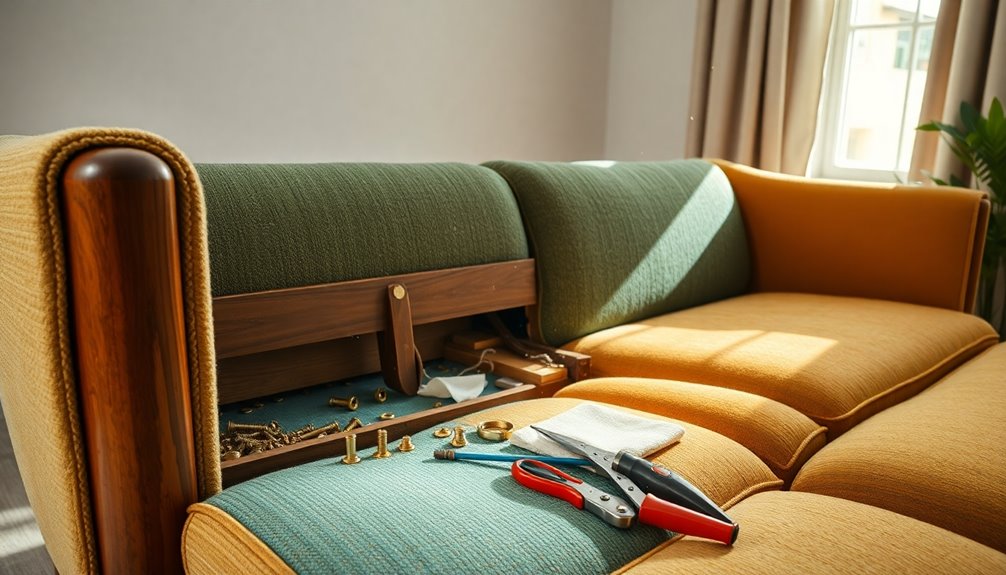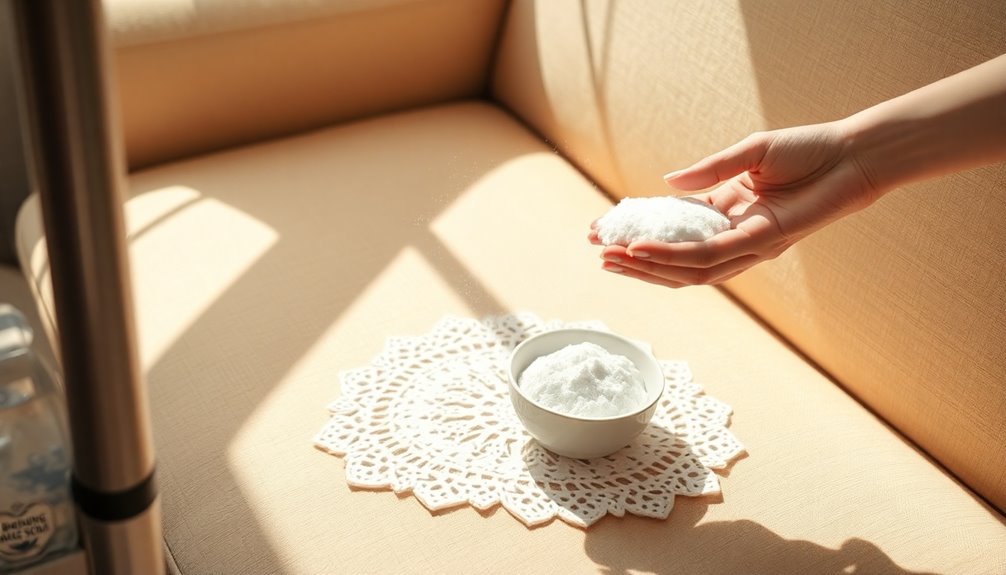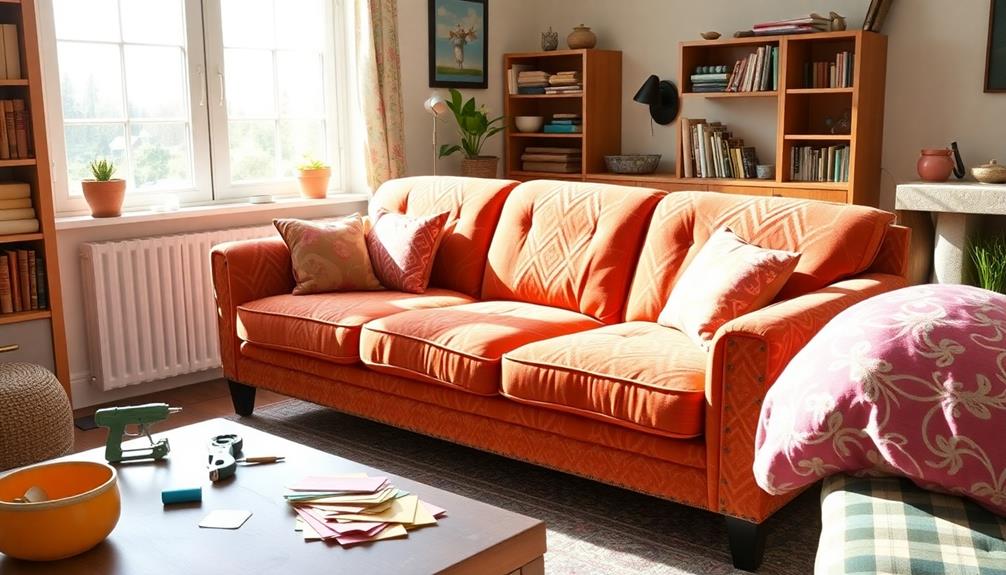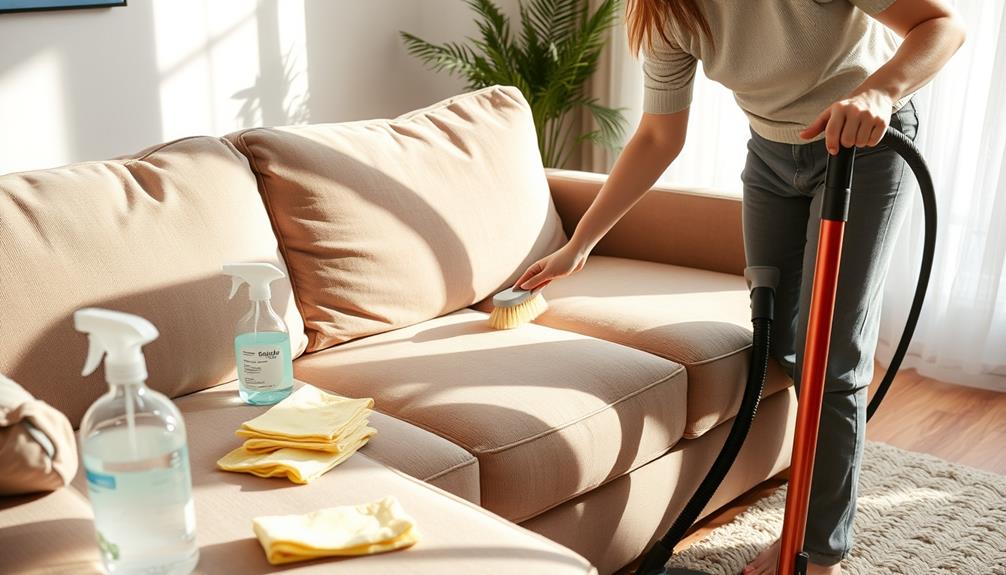To take a sofa apart, start by removing any cushions and slipcovers. Check for screws or bolts on the sofa’s base and armrests, using a wrench or screwdriver to detach them carefully. If your sofa has a wooden frame, gently pry apart the joints, ensuring you don’t damage the wood. With reclining sofas, locate the release mechanisms under the seat. Label and store all hardware in a bag for easy reassembly. Always inspect for any loose screws during the process, as this could be vital for reassembly. You’ll discover more tips that simplify the entire process. Once the main components are disassembled, carefully handle any delicate parts, such as the springs or padding, to prevent any damage. It can be helpful to refer to sofa assembly stepbystep instructions to ensure that every piece is reattached correctly. Finally, take photos during the disassembly process, as this visual aid can be invaluable during reassembly, allowing you to recreate each step with confidence.
Key Takeaways
- Begin by removing any cushions, covers, or upholstery to access the frame and internal components easily.
- Check for screws or bolts securing the frame together and use appropriate tools to carefully unscrew them.
- Look for any hidden fasteners or clips, especially under the sofa or in seams, and gently pry them loose if necessary.
- Disassemble the sofa in sections, starting with the backrest, then arms, and finally the seat, keeping track of all removed parts.
- Consider taking photos during disassembly to assist with reassembly and ensure all components are accounted for.
Introduction
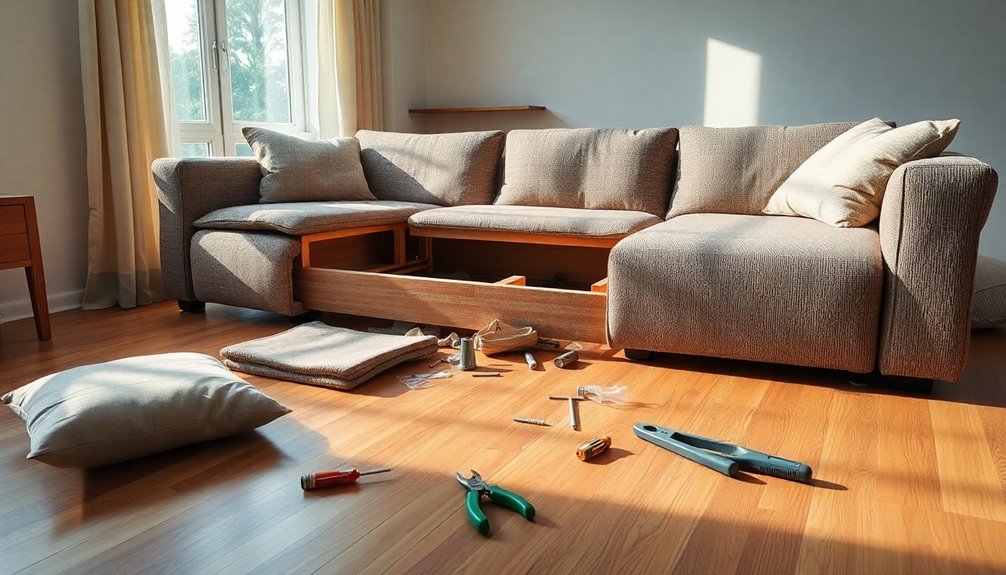
When you take a sofa apart, it's essential to understand how to maintain its fabric effectively. Regular dusting and vacuuming can keep your sofa looking fresh, while knowing the right cleaning techniques for different materials helps preserve its quality. Plus, being prepared for spills, like wine, can save you from bigger headaches down the road.
Routine Dusting and Vacuuming
To keep your sofa looking fresh and extend its lifespan, routine dusting and vacuuming are essential. Regularly cleaning your upholstery helps remove dirt, dust, and allergens that can accumulate over time. Aim to vacuum your sofa at least once a month using a vacuum cleaner equipped with an upholstery attachment. This tool allows you to effectively remove debris from the surface and get into those tricky spots between cushions.
In addition to vacuuming, incorporate routine dusting with a microfiber cloth. This method not only removes dust from the sofa's frame but also prevents particles from settling into the upholstery. Pay particular attention to seams and folds, as these areas often trap dirt and require more thorough cleaning.
For optimal results, consider using a fabric-safe upholstery cleaner alongside your vacuuming efforts. This combination helps address any stains while maintaining your sofa's overall appearance. By committing to these simple maintenance tasks, you'll ensure your sofa remains a centerpiece in your living space, providing both comfort and style for years to come.
Fabric-Specific Cleaning Techniques
Understanding fabric-specific cleaning techniques is crucial for maintaining your sofa's appearance and longevity. Different fabrics require distinct methods to keep your upholstery looking fresh. For instance, cotton can often be machine washed, while leather needs a gentler approach—just wipe it down with a damp cloth and apply a leather conditioner.
Always check the manufacturer's care label for specific cleaning instructions. This step is essential, as some fabrics may require professional cleaning or have restrictions on water use. For synthetic fabrics, a mixture of mild detergent and water can tackle stains effectively, whereas natural fibers benefit from a vinegar and water solution.
Before applying any cleaning solution, test it on a hidden area of the fabric first. This precaution helps ensure you don't accidentally cause discoloration or damage. Regular vacuuming and addressing spills immediately will also extend the life of your sofa's fabric. By following these fabric-specific cleaning techniques, you can keep your upholstery in great shape and enjoy your sofa for years to come.
Treating Wine Spills Effectively
Accidents happen, and a wine spill on your sofa can feel like a disaster. Don't panic; you can effectively treat the stain if you act quickly. First, grab a clean cloth or paper towel and blot the spill gently. This helps absorb as much liquid as possible without rubbing it into the upholstery, which could spread the stain.
Next, mix a solution of one part white vinegar, one part dish soap, and two parts water. Apply this solution to the stained area using a clean cloth to help break down the wine. If the stain proves stubborn, sprinkle some baking soda over the area after applying the vinegar solution. Let it sit for a few minutes before vacuuming it up.
After treating the stain, rinse the area with cold water to remove any cleaning solution residue. Blot it dry with a clean towel. Remember to test any cleaning solution on an inconspicuous spot of the fabric first to ensure it won't cause discoloration or damage. Following these steps will help you remove wine stains and keep your couch looking great!
Avoid Direct Sunlight Exposure

When you're taking your sofa apart, keep it out of direct sunlight to protect its materials. Sunlight can cause fabrics to fade and weaken, while wood and metal can warp or discolor. Selecting scratch-resistant fabrics and using protective throws can help maintain its appearance during the process.
Scratch-Resistant Fabric Selection
Selecting the right scratch-resistant fabric for your sofa is crucial, especially if you want it to withstand daily wear and tear. Look for upholstery materials like microfiber or tightly woven synthetic fibers, as these offer enhanced durability against scratches. Fabrics with a higher rub count—over 30,000—are generally more resistant to abrasion, making them perfect for high-traffic areas in your home.
To ensure your sofa maintains its appearance, avoid placing it in direct sunlight. UV exposure can fade colors and weaken fibers, increasing the risk of scratches. Additionally, consider fabrics treated with protective coatings such as Teflon, which repel stains and help reduce scratching.
Regular maintenance is key to preserving the integrity of your scratch-resistant fabric. Make it a habit to gently brush and vacuum your upholstery, as this will help prolong its lifespan and keep it looking fresh. By making informed choices about fabric selection and committing to consistent maintenance, you can enjoy a beautiful and resilient sofa that withstands the demands of everyday life.
Fabric Protection With Throws
A well-placed throw can be a game changer in protecting your sofa's fabric from the harmful effects of direct sunlight. Without proper fabric protection, your upholstery can start fading in just a few weeks of exposure. Light-colored throws are particularly effective; they reflect sunlight, reducing heat absorption and minimizing damage to the fabric underneath.
To maximize the benefits, position throws strategically on high-wear areas, like armrests and seat cushions. This targeted approach not only protects these vulnerable spots but also prolongs the life of your upholstery. If you're serious about shielding your sofa, consider using UV-resistant fabric for your throws. This extra layer of protection can combat harmful rays that lead to discoloration and degradation.
It's also essential to regularly rotate and wash your throws. This practice maintains their protective qualities and helps prevent dust accumulation, which could contribute to fabric wear over time. By incorporating these simple steps, you can effectively safeguard your sofa from fading while keeping your living space stylish and inviting.
Using Furniture Coasters
Protecting your sofa from damage involves more than just using throws; furniture coasters play a significant role during disassembly. By placing sturdy furniture coasters under each leg of your sofa, you can prevent damage to your floors and allow for easier movement as you take it apart. Ensure that the coasters you use are designed to support the weight of your sofa to avoid slipping or breaking during the process.
While you're disassembling, it's crucial to avoid direct sunlight exposure. Sunlight can fade or weaken your upholstery and materials over time. If you're working outdoors, position the sofa in a shaded area or cover it with a tarp to maintain its integrity.
As you work, regularly check that the coasters remain in place to ensure stability and safety. This will help you avoid any mishaps that could lead to damage to your furniture or your floors. Keeping these tips in mind will make your disassembly process smoother and protect your sofa for years to come.
Routine Check for Loose Screws
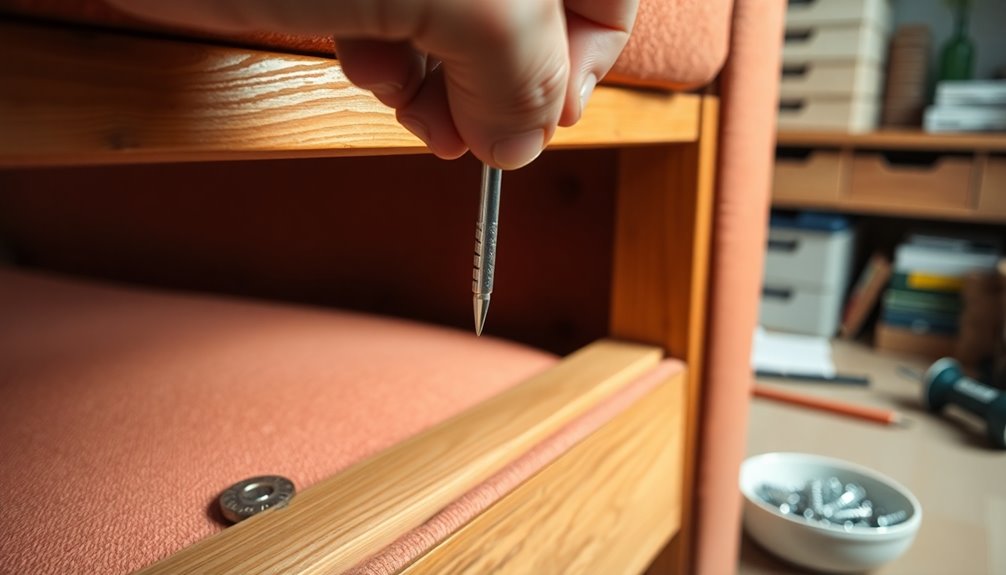
Regularly checking for loose screws keeps your sofa sturdy and helps prevent any issues with joints and connections. If you notice any instability, it's a good time to inspect the fabric for wear and consider fluffing the cushions for added comfort. Staying on top of these routines can save you from more complicated repairs down the line.
Loose Joints and Connections
Over time, your sofa can develop loose joints and connections that may compromise its comfort and stability. Regularly inspect your sofa for any loose screws and fasteners. These small but crucial components play a significant role in maintaining the overall integrity of your furniture. When you notice any loose screws, grab the appropriate screwdriver and tighten them up. This simple act can make a big difference in prolonging the lifespan of your sofa.
Pay close attention to areas that experience frequent movement, like armrests and reclining mechanisms, as these joints are more prone to loosening. To ensure everything is secured properly, consider using a torque wrench to check the tightness of bolts and screws. Just be careful not to over-tighten, as this can damage the wood or frame material.
Schedule routine checks every 6 to 12 months. This proactive approach can help you catch and address any loose joints early, preventing potential damage and ensuring your sofa remains comfortable and stable for years to come. Keeping your sofa in good shape is essential for a cozy living space.
Fabric Repair and Conditioning
Maintaining your sofa's fabric is crucial for its longevity and appearance. Regularly inspect the upholstery for signs of wear, like fraying or loose seams. Addressing these issues promptly can significantly extend the life of your sofa. If you spot any damage, consider using a fabric repair kit to patch up small tears or snags. This simple step helps preserve both the aesthetics and functionality of your furniture.
Additionally, don't overlook the importance of conditioning your sofa's fabric. Use a suitable fabric conditioner to maintain its texture and prevent fading from sunlight exposure. This routine maintenance keeps your upholstery looking fresh and vibrant.
While you're checking the fabric, take a moment to inspect the frame of your sofa. Loose screws and fasteners can compromise the structure, leading to further damage to the upholstery. Tighten any loose screws with the appropriate screwdriver to ensure stability. By keeping both the fabric and frame well-maintained, you'll enhance your sofa's durability and comfort, making it a staple in your living space for years to come.
Cushion Fluffing Techniques
Although it might seem like a minor detail, regularly fluffing your sofa cushions can make a big difference in both comfort and appearance. Start by inspecting the couch frame for loose screws. Use a Phillips head screwdriver to tighten any fasteners on the arms, legs, or backrest. This is essential for maintaining structural integrity and preventing wobbling or potential collapse.
Once you've ensured everything is securely fastened, move on to the cushions. If you notice any sagging, it could mean the internal support structure needs adjustment. To fluff your cushions, beat or shake them gently, allowing the filling to redistribute. This helps restore their shape and prevents permanent indentations.
If your sofa has removable legs, consider taking them off while you work on the cushions for easier access. Remember, regular maintenance not only enhances comfort but also prolongs the life of your sofa. By incorporating these cushion fluffing techniques and checking for loose screws, you're taking a proactive approach to keeping your sofa in top condition. So, give your cushions the care they need for a cozy, inviting space.
Personalized Fabric Choices
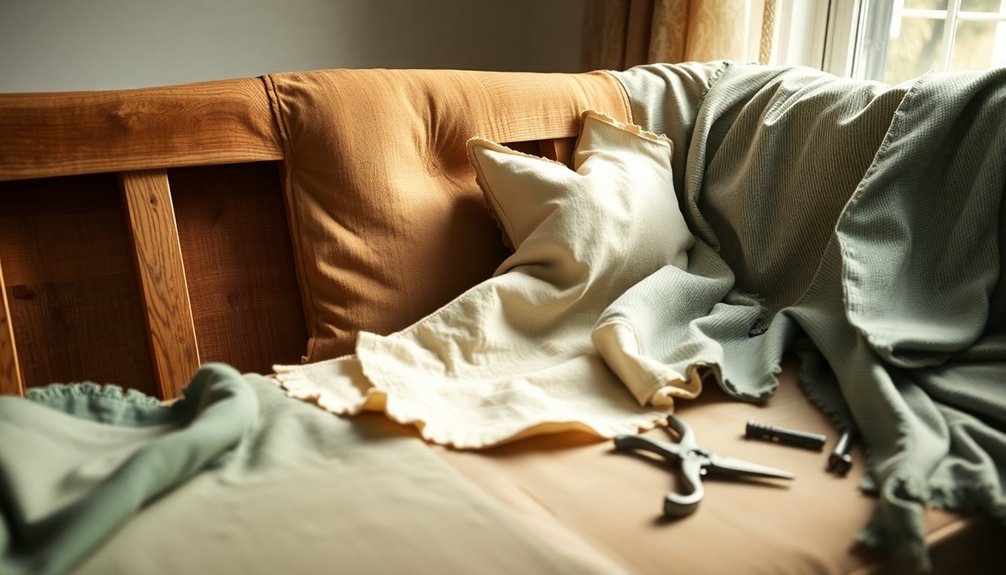
Choosing fabric for your sofa can significantly influence its appearance and longevity, so it's essential to consider personalized options that reflect your style. Start by evaluating fabrics based on durability ratings like the Martindale or Wyzenbeek tests. For residential use, aim for a minimum of 15,000 rubs to ensure your upholstery withstands daily wear.
Opt for stain-resistant treatments, particularly polyester blends, which enhance durability and simplify maintenance. While natural fibers like cotton and linen offer comfort and breathability, they often require more upkeep and can be less resistant to damage.
To truly personalize your sofa, explore custom upholstery options that allow you to select patterns, colors, and textures suited to your tastes and home decor. Always review care instructions for your chosen fabric; some may need professional cleaning, while others can be easily maintained with a damp cloth or mild detergent.
Cushion Replacement Strategies

When it comes to revitalizing your sofa, replacing the cushions can make a significant difference in both comfort and appearance. Start by measuring your existing cushions accurately; use a tape measure for precise dimensions to ensure a proper fit for your new replacements. Consider the density and firmness of the foam you select, as higher density options generally provide better support and durability over time.
When choosing cushion covers, look for ones with zippers, making them easy to remove and wash. This promotes better maintenance and extends the life of your cushions. Don't hesitate to explore different fill types, like down, polyester, or memory foam, to find the comfort level that suits your seating preferences. If you're environmentally conscious, consider eco-friendly options made from recycled materials or natural fibers, which can add a sustainable touch to your home. Additionally, opting for multi-functional furniture can further enhance your space's utility while keeping it stylish.
Conclusion
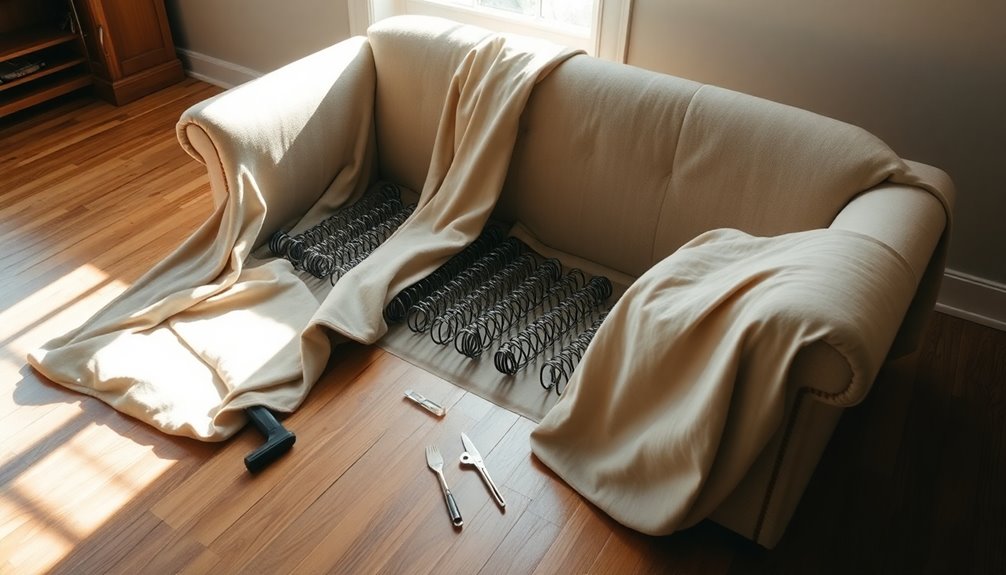
In summary, taking a sofa apart can be a rewarding project that enhances your furniture's longevity and offers opportunities for renewal. By following a systematic approach, you can efficiently dismantle your sofa, starting with the removal of cushions and upholstery. This allows you to access the frame and fasteners, making the process smoother. On average, expect to spend about 4 to 6 hours on this task, depending on the sofa's complexity and the tools you have at hand.
Utilizing the right tools, like screwdrivers and staple pullers, can make disassembly safer and easier. As you work, keep the removed components organized and labeled so you can easily reassemble or dispose of them later. If you're looking to dispose of your sofa, consider options that are environmentally responsible. You can remove the mattress and donate usable parts or take them to a recycling center. This way, you not only give your sofa a new life but also contribute to reducing waste. Embrace the challenge, and you'll find that taking apart a sofa is both practical and fulfilling.
Frequently Asked Questions
Can Sofas Be Disassembled?
Yes, most sofas can be disassembled, making it easier for you to transport them, especially in tight spaces. You'll find that many sofas have removable parts like legs, arms, and backrests, secured with screws or bolts. Before you start, check the design of your sofa to see if it's modular or has special mechanisms. Gather the right tools, like screwdrivers and wrenches, to ensure the process goes smoothly and efficiently.
Can You Take a Couch Apart to Fit Through a Door?
Yes, you can take a couch apart to fit it through a door. Start by measuring the couch and the doorway to ensure a good fit. Remove cushions, legs, and possibly armrests or backrests. You'll need some tools like a screwdriver and an Allen wrench. Make sure your workspace is clean so you can keep track of the parts you remove. This way, you'll reassemble everything easily once you've maneuvered it through the door.
How to Disassemble a Sofa for Moving?
To disassemble a sofa for moving, start by removing all loose cushions and any detachable parts. Check for hidden items before setting them aside. Use a screwdriver or Allen wrench to unscrew and detach the arms, backrest, and legs, labeling fasteners for easy reassembly. If needed, flip the sofa upside down to access the frame. Finally, carefully wrap the components for protection during transport, and consider getting help for heavy parts.
Do the Backs of Couches Come Apart?
Yes, the backs of many couches do come apart. You'll often find removable backs secured by screws, bolts, or metal strips. Before you start, check for hidden fasteners or upholstery that might need to be removed first. Depending on the design, you might need to lift the back off after releasing levers or unscrewing visible fasteners. Always refer to your sofa's manufacturer guidelines for specific instructions to avoid any damage.
